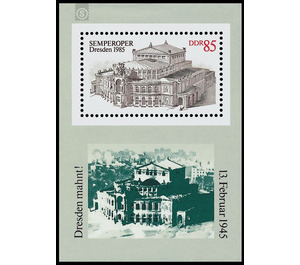Reopening of the Semperoper, Dresden 1985 - Germany / German Democratic Republic 1985
Theme: Architecture
| Country | Germany / German Democratic Republic |
| Issue Date | 1985 |
| Item Type | Block |
| Chronological Issue Number | 3182 |
| Chronological Chapter | GER-DDR |
| SID | 878738 |
| In 21 Wishlists | |
Semperoper, Dresden 1985 With the illustrations of the reconstructed Semperoper in 1985 and the destroyed opera in 1945, the Ministry of Posts and Telecommunications of the German Democratic Republic issues a multi-colored special postage stamp block. No special First Day Cover Special cancellation from February 12 to April 11, 1985 The Semperoper in Dresden - newly acquired in the old splendor On February 13, 1985, the Semper Opera House in Dresden will be opened with the festive performance of Carl Maria von Weber's "Freischütz". This is one of the most traditional European opera houses his game operation again. Forty years earlier, the opera house created by Gottfried Semper sank and with it the city center of Dresden, rich in cultural and historical buildings, rubble and ashes. Without any military necessity, the "Elbflorenz" on 13 February 1945 was the victim of an Anglo-American bombing raid and thus seemed to be sealed the fate of the Semper Opera House. Built according to designs by Gottfried Semper under the direction of his son Manfred in the period 1871 - 1878, it was considered in its architectural design and urban integration as a mature achievement of the 19th century, in which architecture, fine arts and craftsmanship in a rare harmony an impressive festive unity unified. Legendary acoustics contributed to making performances at the Dresden Opera a lasting artistic experience, including many original and first performances. Richard Strauss, who was closely associated with this opera house, premiered here his "Rosenkavalier" (1911) and "The Silent Woman" (1935). Important conductors (such as Ernst v. Schuch) and singers (such as Tino Patiera, Maria Cebotciri, Margaret Teschenmacher, Josef Herrmann, Heinrich Pflanzl) worked here and established the reputation of the Dresdner Oper. Already in February 1950 it had been decided to construct the building of the Semperoper and to prepare its reconstruction. The auditorium, the stage house and the foyers were roofed, the gables secured and the ruined facade of the auditorium restored. At the same time, proposals for decisions on the way of future reconstruction in the context of functional considerations for the future opera have been started. In March 1976, the Council of Ministers of the German Democratic Republic confirmed the concept for the reconstruction of the Semper Opera House, so that the laying of the foundation stone could take place on 25 June 1977. The exterior design took place in the historic architecture, only in the stage area, the side walls had to be moved out to make room for the required side stages. The stage itself is with the z. Z. equipped with the latest technical possibilities. The auditorium was enlarged in volume by altering the perimeter walls, thus creating the conditions for the required increase in row spacing, chair widths and for the removal of visually impaired places. He will provide space for about 1,300 visitors in the future. The design of the architectural motifs and all the decorative details as well as the artistic decoration took place in the sense of Semper. As a result, the interior design again gains its historical character. Thus, the interior and exterior of the Semperbau was largely preserved in its original form and subordinate modern functional buildings were erected at the rear, connected by transitions. The Ensemble of the Dresden State Opera once again has a splendid venue, which will at the same time meet the most modern functional requirements. Already on August 10, 1945, the ensemble of the Dresden State Opera had begun its artistic activity under the conditions of complicated conditions under the performance of Mozart's "Figaro". Since 1948, the ensemble was the theater after reconstruction completed. With interesting productions, among them a multiplicity of GDR premiere performances (S. Prokofjew, B. Britten, W. Eyk and others) and world premieres (K.R. Grießbach, R. Kunad, U. Zimmermann) it gained again validity in Europe. Drivers such as J. Keilberth, R. Kempe, F. Konwitschny, 0. Suitner and singers such as H. Ambros, P. Schreier and Th. Adam contributed to this.


